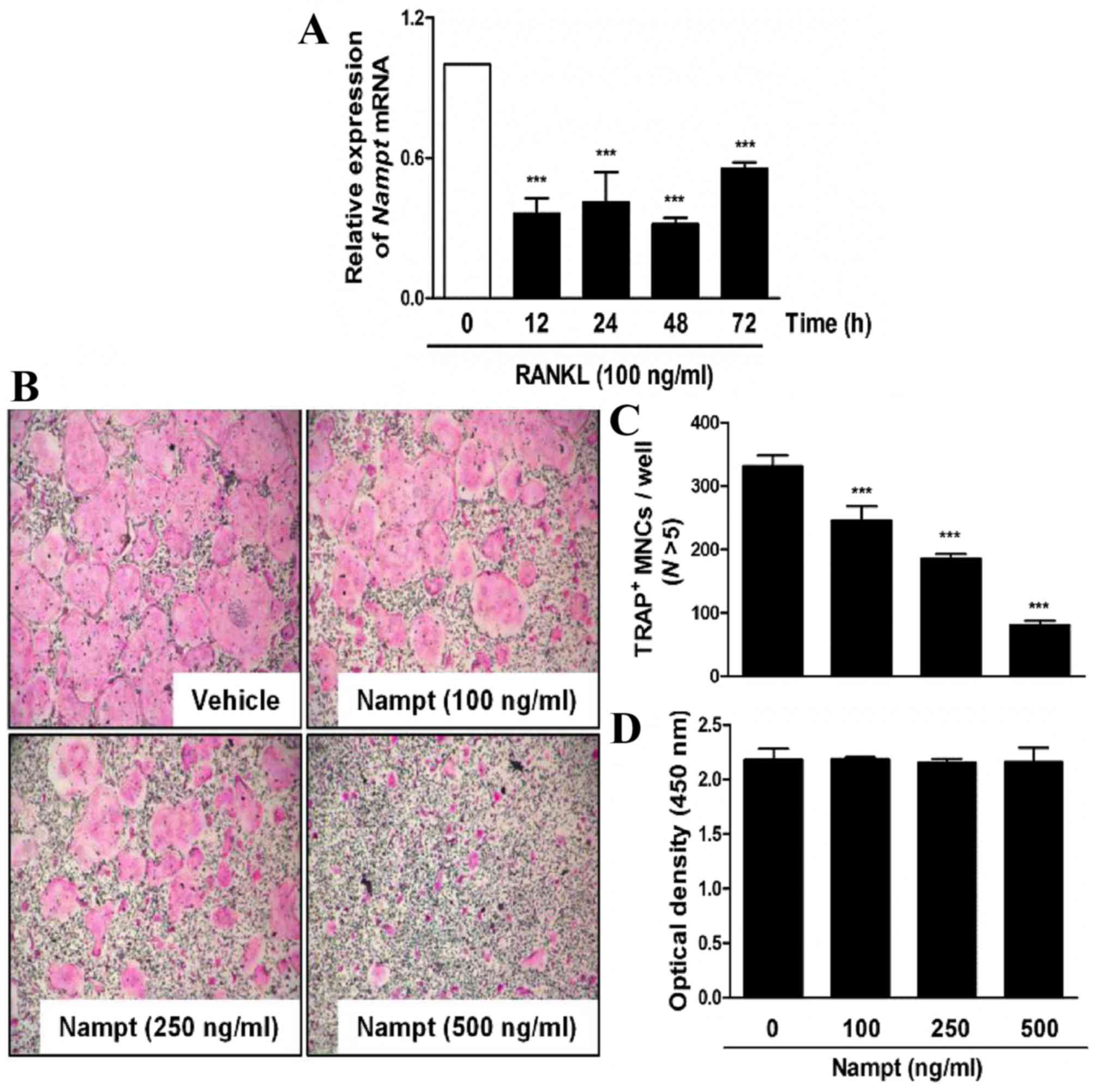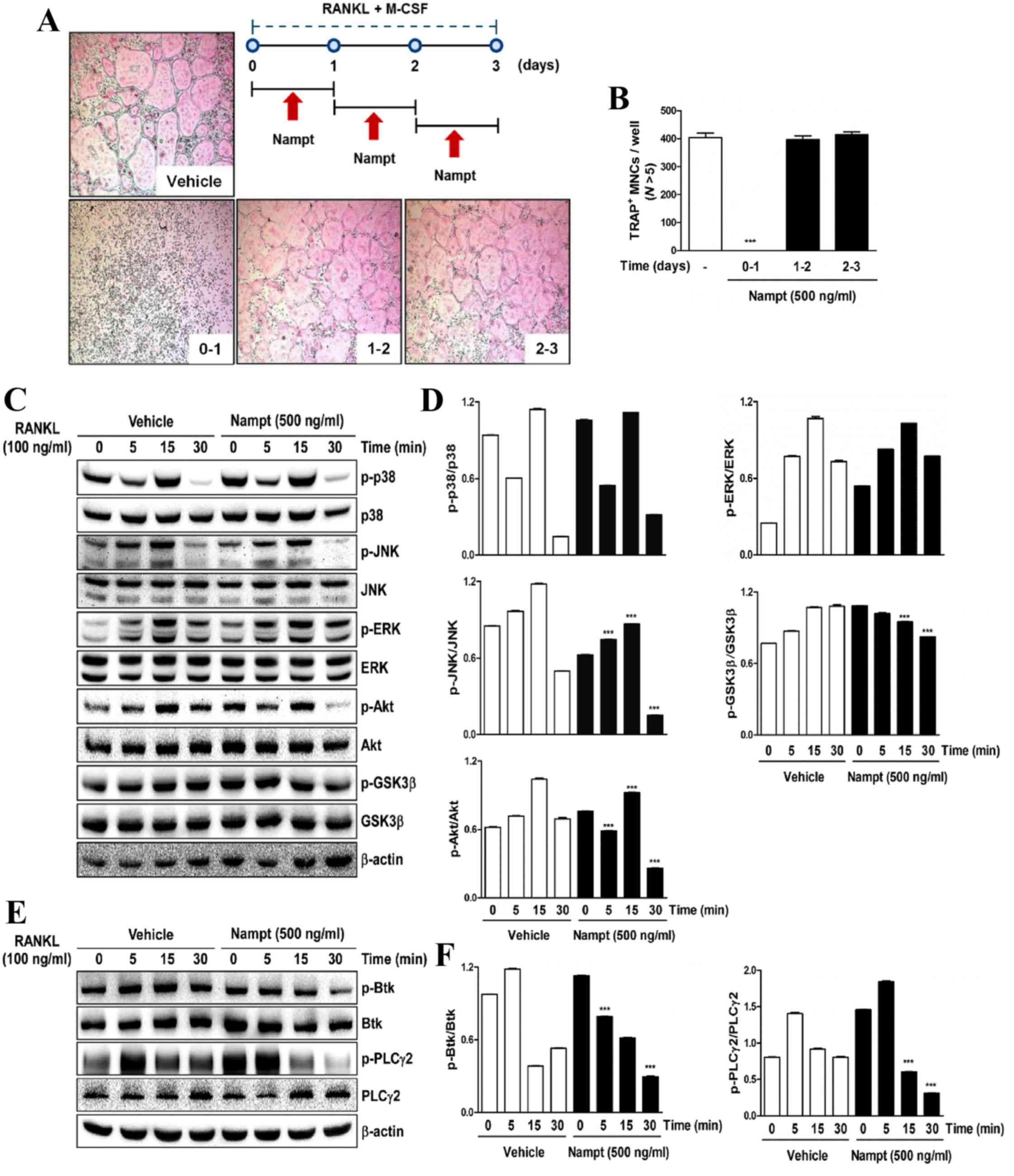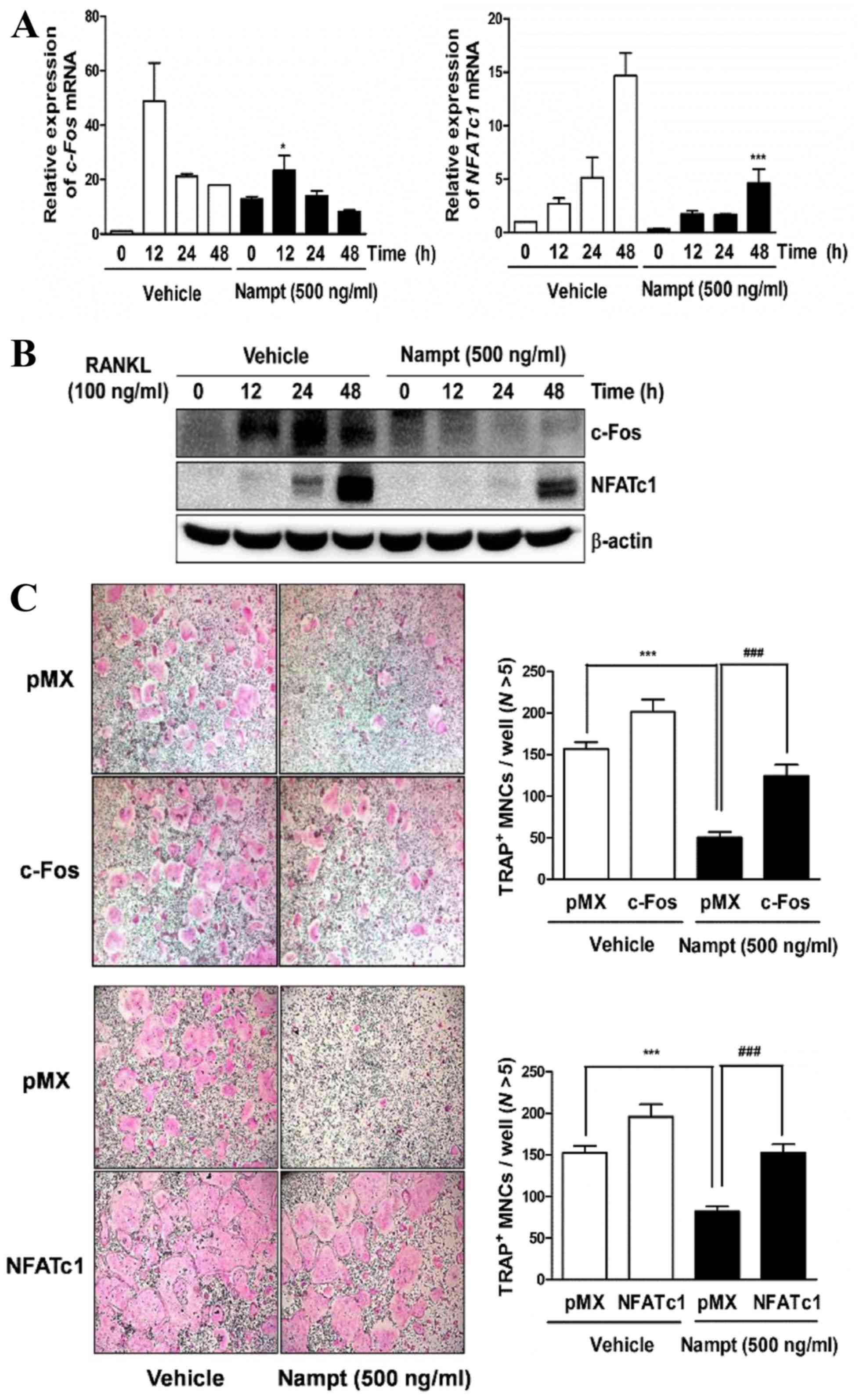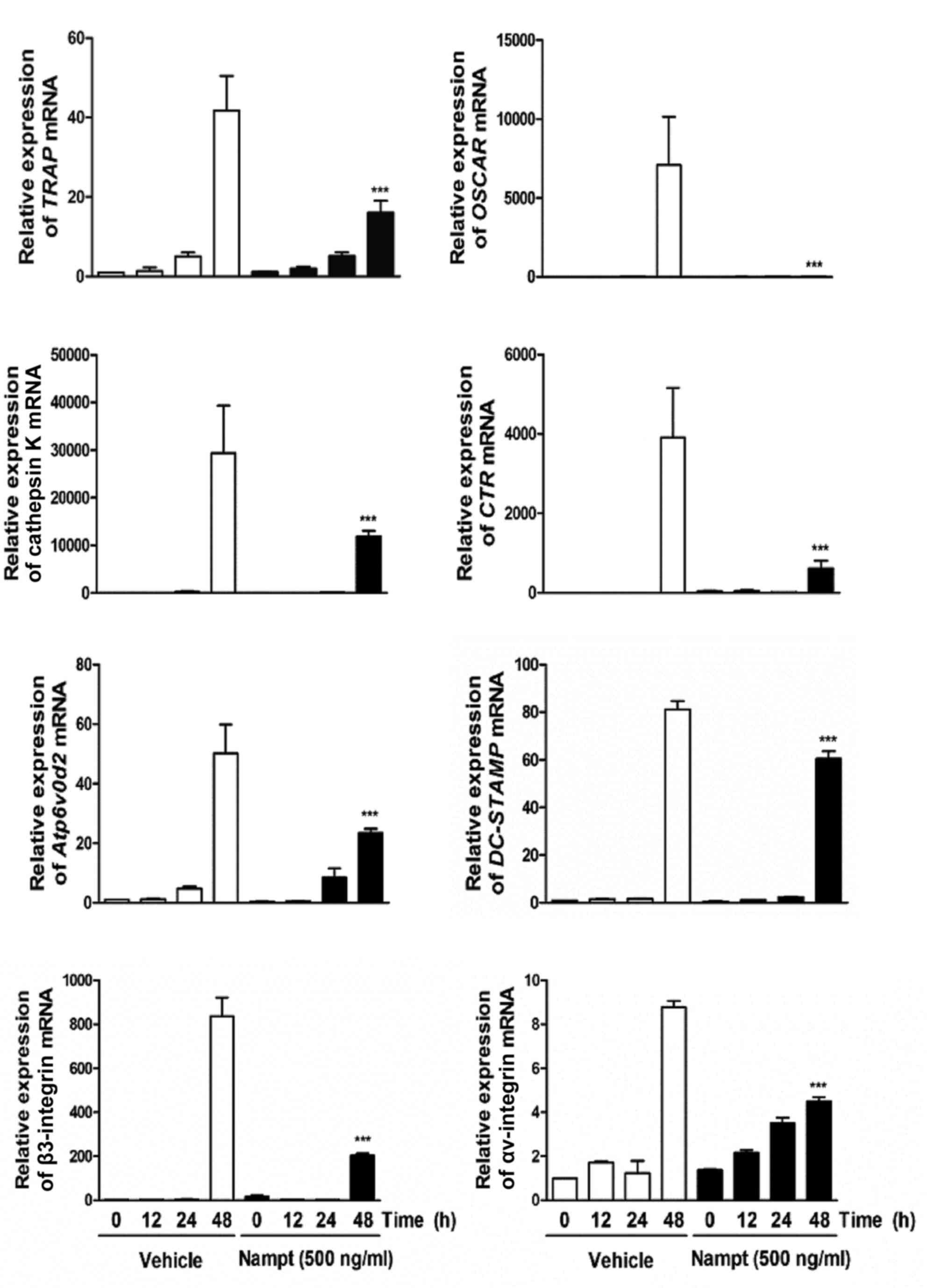|
1
|
Samal B, Sun Y, Steams G, Xie C, Suggs S
and McNiece I: Cloning and characterization of the cDNA encoding a
novel human pre-B-cell colony-enhancing factor. Mol Cell Biol.
14:1431–1437. 1994. View Article : Google Scholar : PubMed/NCBI
|
|
2
|
Luk T, Malam Z and Marshall JC: Pre-B cell
colony-enhancing factor (PBEF)/visfatin: A novel mediator of innate
immunity. J Leukoc Biol. 83:804–816. 2006. View Article : Google Scholar
|
|
3
|
Gosset M, Berenbaum F, Salvat C, Sautet A,
Pigenet A, Tahiri K and Jacques C: Crucial role of visfatin/pre-B
cell colony-enhancing factor in matrix degradation and
prostaglandin E2 synthesis in chondrocytes: Possible influence on
osteoarthritis. Arthritis Rheum. 58:1399–1409. 2008. View Article : Google Scholar : PubMed/NCBI
|
|
4
|
Moschen AR, Kaser A, Enrich B, Mosheimer
B, Theurl M, Niederegger H and Tilg H: Visfatin, an adipocytokine
with proinflammatory and immunomodulating properties. J Immunol.
178:1748–1758. 2007. View Article : Google Scholar : PubMed/NCBI
|
|
5
|
Revollo JR, Grimm AA and Imai S: The NAD
biosynthesis pathway mediated by nicotinamide
phosphoribosyltransferase regulates Sir2 activity in mammalian
cells. J Biol Chem. 279:50754–50763. 2004. View Article : Google Scholar : PubMed/NCBI
|
|
6
|
Tan B, Dong S, Shepard RL, Kays L, Roth
KD, Geeganage S, Kuo MS and Zhao G: Inhibition of nicotinamide
phosphoribosyltransferase (NAMPT), an enzyme essential for NAD+
biosynthesis, leads to altered carbohydrate metabolism in cancer
cells. J Biol Chem. 290:15812–15824. 2015. View Article : Google Scholar : PubMed/NCBI
|
|
7
|
Yang S, Ryu JH, Oh H, Jeon J, Kwak JS, Kim
JH, Kim HA, Chun CH and Chun JS: NAMPT (visfatin), a direct target
of hypoxia-inducible factor-2α, is an essential catabolic regulator
of osteoarthritis. Ann Rheum Dis. 74:595–602. 2015. View Article : Google Scholar : PubMed/NCBI
|
|
8
|
Liu Y, Song CY, Wu SS, Liang QH, Yuan LQ
and Liao EY: Novel adipokine and bone metabolism. Int J Endocrinol.
2013:8950452013. View Article : Google Scholar : PubMed/NCBI
|
|
9
|
Wattanachanya L, Lu WD, Kundu RK, Wang L,
Abbott MJ, O'Carroll D, Quertermous T and Nissenson RA: Increased
bone mass in mice lacking the adipokine apelin. Endocrinology.
154:2069–2080. 2013. View Article : Google Scholar : PubMed/NCBI
|
|
10
|
Kamio N, Kawato T, Tanabe N, Kitami S,
Morita T, Ochiai K and Maeno M: Vaspin attenuates RANKL-induced
osteoclast formation in RAW264.7 cells. Connect Tissue Res.
54:147–152. 2013. View Article : Google Scholar : PubMed/NCBI
|
|
11
|
Tu Q, Zhang J, Dong LQ, Saunders E, Luo E,
Tang J and Chen J: Adiponectin inhibits osteoclastogenesis and bone
resorption via APPL1-mediated suppression of Akt1. J Biol Chem.
286:12542–12553. 2011. View Article : Google Scholar : PubMed/NCBI
|
|
12
|
Venkateshaiah SU, Khan S, Ling W, Bam R,
Li X, van Rhee F, Usmani S, Barlogie B, Epstein J and Yaccoby S:
NAMPT/PBEF1 enzymatic activity is indispensable for myeloma cell
growth and osteoclast activity. Exp Hematol. 41:547.e2–557.e2.
2013. View Article : Google Scholar
|
|
13
|
Moschen AR, Geiger S, Germer R and Tilg H:
Pre-B cell colony enhancing factor/NAMPT/visfatin and its role in
inflammation-related bone disease. Mutat Res. 690:95–101. 2010.
View Article : Google Scholar : PubMed/NCBI
|
|
14
|
Kim JY, Cheon YH, Oh HM, Rho MC,
Erkhembaatar M, Kim MS, Lee CH, Kim JJ, Choi MK, Yoon KH, et al:
Oleanolic acid acetate inhibits osteoclast differentiation by
downregulating PLCγ2-Ca(2+)-NFATc1 signaling, and suppresses bone
loss in mice. Bone. 60:104–111. 2014. View Article : Google Scholar : PubMed/NCBI
|
|
15
|
Glantschnig H, Fisher JE, Wesolowski G,
Rodan GA and Reszka AA: M-CSF, TNFalpha and RANK ligand promote
osteoclast survival by signaling through mTOR/S6 kinase. Cell Death
Differ. 10:1165–1177. 2003. View Article : Google Scholar : PubMed/NCBI
|
|
16
|
Li X, Udagawa N, Itoh K, Suda K, Murase Y,
Nishihara T, Suda T and Takahashi N: p38 MAPK-mediated signals are
required for inducing osteoclast differentiation but not for
osteoclast function. Endocrinology. 143:3105–3113. 2002. View Article : Google Scholar : PubMed/NCBI
|
|
17
|
Kobayashi N, Kadono Y, Naito A, Matsumoto
K, Yamamoto T, Tanaka S and Inoue J: Segregation of TRAF6-mediated
signaling pathways clarifies its role in osteoclastogenesis. EMBO
J. 20:1271–1280. 2001. View Article : Google Scholar : PubMed/NCBI
|
|
18
|
Gingery A, Bradley E, Shaw A and Oursler
MJ: Phosphatidylinositol 3-kinase coordinately activates the
MEK/ERK and AKT/NFkappaB pathways to maintain osteoclast survival.
J Cell Biochem. 89:165–179. 2003. View Article : Google Scholar : PubMed/NCBI
|
|
19
|
Shinohara M, Koga T, Okamoto K, Sakaguchi
S, Arai K, Yasuda H, Takai T, Kodama T, Morio T, Geha RS, et al:
Tyrosine kinases Btk and Tec regulate osteoclast differentiation by
linking RANK and ITAM signals. Cell. 132:794–806. 2008. View Article : Google Scholar : PubMed/NCBI
|
|
20
|
Ikeda F, Matsubara T, Tsurukai T, Hata K,
Nishimura R and Yoneda T: JNK/c-Jun signaling mediates an
anti-apoptotic effect of RANKL in osteoclasts. J Bone Miner Res.
23:907–914. 2008. View Article : Google Scholar : PubMed/NCBI
|
|
21
|
Moon JB, Kim JH, Kim K, Youn BU, Ko A, Lee
SY and Kim N: Akt induces osteoclast differentiation through
regulating the GSK3β/NFATc1 signaling cascade. J Immunol.
188:163–169. 2012. View Article : Google Scholar : PubMed/NCBI
|
|
22
|
Wilde JI and Watson SP: Regulation of
phospholipase C gamma isoforms in haematopoietic cells: Why one,
not the other? Cell Signal. 13:691–701. 2001. View Article : Google Scholar : PubMed/NCBI
|
|
23
|
Mao D, Epple H, Uthgenannt B, Novack DV
and Faccio R: PLCgamma2 regulates osteoclastogenesis via its
interaction with ITAM proteins and GAB2. J Clin Invest.
116:2869–2879. 2006. View Article : Google Scholar : PubMed/NCBI
|
|
24
|
Wisdon R and Verma IM: Transformation by
Fos proteins requires a C-terminal transactivation domain. Mol Cell
Biol. 13:7429–7438. 1993. View Article : Google Scholar : PubMed/NCBI
|
|
25
|
Grigoriadis AE, Wang ZQ, Cecchini MG,
Hofstetter W, Felix R, Fleisch HA and Wagner EF: c-Fos: A key
regulator of osteoclast-macrophage lineage determination and bone
remodeling. Science. 266:443–448. 1994. View Article : Google Scholar : PubMed/NCBI
|
|
26
|
Takayanagi H: The role of NFAT in
osteoclast formation. Ann N Y Acad Sci. 1116:227–237. 2007.
View Article : Google Scholar : PubMed/NCBI
|
|
27
|
Takayanagi H, Kim S, Koga T, Nishina H,
Isshiki M, Yoshida H, Saiura A, Isobe M, Yokochi T, Inoue J, et al:
Induction and activation of the transcription factor NFATc1 (NFAT2)
integrate RANKL signaling in terminal differentiation of
osteoclasts. Dev Cell. 3:889–901. 2002. View Article : Google Scholar : PubMed/NCBI
|













